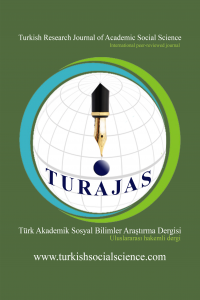Firdevsî-i Rûmî’nin Süleyman-nâmesi’nin Düzenleniş Biçimi (37 ve 76. Cilt Örnekleminde)
Firdevsî-i Rûmî, on beşinci yüzyılın ikinci yarısı ile on altıncı yüzyılın başında yaşamış üretken bir yazardır. En önemli ve hacimli eseri Süleyman-nâme-i Kebîr’dir. Gayretli yazar Firdevsî, ömrünü bu eseri tamamlamak için harcamıştır. Bu esere II. Mehmet’in teşviki ile başlamıştır. Firdevsî, Allah’ın isimleri adedince doksan dokuz cilt, hacimli bir eser tasarlar. Yavuz Sultan Selim döneminin başlarında 81. cilde kadar muvaffak olur. Metinde Süleyman Peygamber’in dinini yayma çabası, kendisine tabi olmayanlarla mücadelesi anlatılır. Hayali ve gerçek hikâyeler nazım/nesir ifade edilmiştir. Bu hikâyelerde Hz. Süleyman’ın karşılaştığı insanlarla, hayvanlarla, cinlerle, devlerle ve meleklerle yaptığı konuşmalar aktarılır. Bu anlatımlar esnasında coğrafya, astronomi, sağlık, kimya, hayvan bilimi, metafizik, doğa olayları hakkında bilgiler verilir. Firdevsî hikemî üslup sahibidir. Eserlerinde eğitici, öğretici ve kıssadan hisse almaya yönelik bir anlatım tarzı tercih etmiştir. Anlam derinlerde değil, yüzeyseldir. Sanat kaygısından uzaktır. Bu hacimli eseri incelediğimizde yazarın metni belli bir sistem dâhilinde oluşturduğu anlaşılır. 81 ciltte de aynı düzen görülür. Metnin otuz yedi ve yetmiş altı ciltleri temelinde bu düzen örneklendirilmiştir. Ciltler incelendiğinde metinlerin üç bölümden oluştuğu anlaşılmıştır. Giriş bölümünde kasidelerle yazar sanat yeteneğini gösterme çabası içinde olmuştur. Asıl konunun işlendiği meclislerde nispeten konuşma diline yakın bir üslup benimsemiş, bitiş bölümünde metni dualarla bitirmiştir. Çalışmada bu hacimli eserin düzeni ortaya çıkarılarak eser hakkında araştırma yapanlara yol gösterici olmak amaçlanmıştır.
The Arrangement of Firdevsi-i Rumi’s Süleyman-name (In the Sample of Volumes 37 and 76)
Firdevsi-i Rumi is a prolific writer who lived in the second half of the fifteenth century and the beginning of the sixteenth century. His most important and voluminous work is Süleyman-name-i kebir. Firdevsi is a diligent writer who spent his life completing this work. The author of this work II. It started with Mehmet's encouragement. Firdevsi designs a voluminous work in ninety-nine volumes, as many as the names of Allah. At the beginning of the reign of Yavuz Sultan Selim, he succeeds until the 81st volume. In the text, the effort of the Prophet Solomon to spread his religion and his struggle with those who are not subject to him are told. Imaginary and real stories are expressed in verse/prose. In these stories, St. The conversations Solomon had with the people, animals, jinn, giants and angels he encountered are reported. During these lectures, information is given about geography, astronomy, health, chemistry, animal science, metaphysics and natural events. While depicting the Divan of the Prophet Solomon, his greatness is revealed. Firdevsî has a hikemi style. In his works, he preferred a narrative style that was educational, instructive and to get a share of the story. The meaning is not deep, it is superficial. Art is free from anxiety. When we examine this voluminous work, it is understood that the author created the text within a certain system. The same order is seen in 81 volumes. This order is exemplified on the basis of the thirty-seven and seventy-six volumes of the text. When the volumes were examined, it was understood that the texts consisted of three parts. In the introduction, the author has been in an effort to show his artistic talent with the odes. In the assemblies where the main subject is handled, it has adopted a style that is relatively close to the spoken language. In the concluding part, he ends the text with prayers. By revealing the layout of this voluminous work, it is aimed to guide those who research about the work.
___
- Alper, Kadir (2014). Türk Edebiyatında Süleymân-nâmeler. Turkish Studies International Periodical For the Languages, Literature and History of Turkish or Turkic. Volume 9/7. ss.147-163.
- Banarlı, Nihad Sami (2011). Resimli Türk Edebiyatı Tarihi. C. 1. İstanbul: Milli Eğitim Basımevi.
- Biçer, Bekir (2005). Firdevsî-i Rûmî ve Tarihçiliği. Doktora Tezi. Konya: Selçuk Üniversitesi Sosyal Bilimler Enstitüsü.
Çantay, Hasan Basri (1981). Kur’ân-ı Hakim ve Meâl-i Kerim. İstanbul.
- Eren, Hulusi. (2018). Firdevsî-i Rûmî, Süleymân-nâme-i Kebîr -34-35. Ciltler (İnceleme-Tenkitli Metin-Dizin). Yayımlanmamış Doktora Tezi. Ankara: Hacettepe Üniversitesi.
- Firdevsi-i Rûmî, Süleyman-nâme-i Kebîr, Topkapı Sarayı Müzesi Hazine Kitaplığı NüshasıArşiv Numarası: H.1529
- Firdevsi-i Rûmî, Süleyman-nâme-i Kebîr. Topkapı Sarayı Müzesi Hazine Kitaplığı NüshasıArşiv Numarası: 1231
- Gök, Adem (2019). Firdevsî-i Rûmî, Süleymân-nâme-i Kebîr (37. Cilt) İnceleme, Tenkitli Metin. Yayımlanmamış Doktora Tezi.Isparta: Süleyman Demirel Üniversitesi.
- Ünal, Mehmet (2023), Uzun Firdevsî’den Mitolojik Hikâyeler, Isparta: Elya Yayınları.
